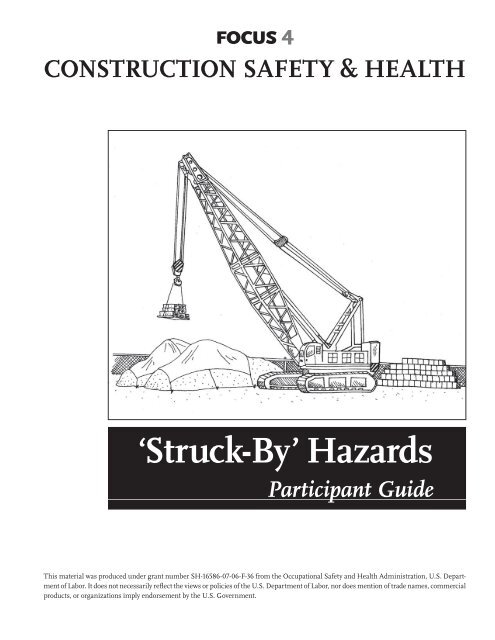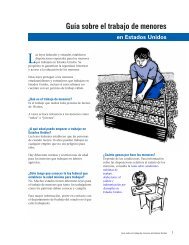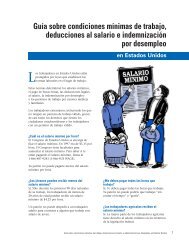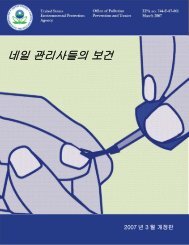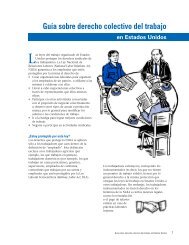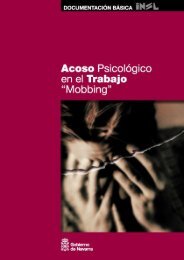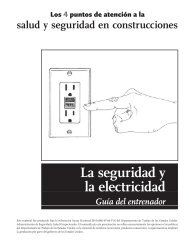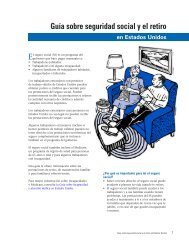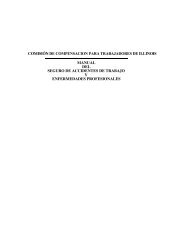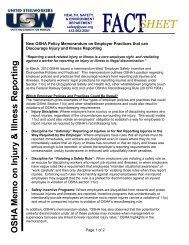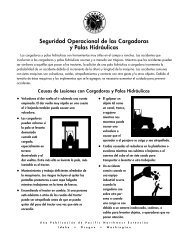Struck-by Hazards: A Participant's Guide - OSHA
Struck-by Hazards: A Participant's Guide - OSHA
Struck-by Hazards: A Participant's Guide - OSHA
- No tags were found...
Create successful ePaper yourself
Turn your PDF publications into a flip-book with our unique Google optimized e-Paper software.
SECTION #2“<strong>Struck</strong>-By” <strong>Hazards</strong>Being struck <strong>by</strong> an object is one of the leading causes of construction-related deaths.Workers are most often struck <strong>by</strong>:● heavy equipment and vehicles, likes trucks and cranes;● falling or flying objects, like tools and flying particles;● concrete or masonry walls that are being constructedEmployers must protect workers from being struck <strong>by</strong> vehicles and objects on the job. While thesehazards exist, there are ways to prevent or reduce injuries from these types of hazards. These are calledcontrol measures, and workers must ensure that control measures are in place to ensure their safety.Crane Safety: Can the crane operator see you? Stay out of the“swing radius” – of the cab and of the load – and never get undera suspended load.Tool Safety: Picture shows the movable lowerguard of this circular saw in its fully raisedposition and with the blade fully exposed belowthe base plate.Prevent “kick-back” of the saw <strong>by</strong> adjustingthe blade exposure to the minimum distanceneeded, with saw teeth extending just beyond thethickness of the material you are cutting.Unsafe Work: You must cap the ends of exposed “rebars”(reinforcing bars) if anyone can walk into them or fall onto them.Tool Safety: Always make sure the head of thehammer is fi rmly attached to the handle so thehead doesn’t fl y off.SECTION #2 | Participant <strong>Guide</strong> 1 “<strong>Struck</strong>-By” <strong>Hazards</strong>
mEXERCISEmControlling “<strong>Struck</strong>-By” <strong>Hazards</strong>Divide the group into three smaller groups. Each group must come up with answers on how tocontrol the hazards they are assigned.1. HAZARD: VEHICLES HOW DO WE WORK SAFELY? (Control Measures)1. Driving a vehicle at work2. Driving a vehicle that is notproperly maintained3. Driving vehicle in reverse gear4. Parking on an incline5. Using lifting or dumping devices6. Carrying / lifting heavy loads7. Operating powered industrialtrucks (forklifts)8. Working on public roadwaysGENERAL: WEAR HARD HATS. STACK AND SECURE MATERIALS TO PREVENT SLIDINGOR COLLAPSE.SECTION #2 | Participant <strong>Guide</strong> 2 “<strong>Struck</strong>-By” <strong>Hazards</strong>
2. HAZARD: FALLING/FLYINGOBJECTSHOW DO WE WORK SAFELY? (Control measures)1. Working underneath cranes,hoists, scaffolds2. Performing overhead work3. Working with hand tools4. Working with power tools, suchas saws, drills, grinders5. Working with machines, such asjack hammers, pavement saws6. Working with powder-actuatedtools7. Pushing or pulling objects thatmay become airborne8. Working with compressed airSECTION #2 | Participant <strong>Guide</strong> 3 “<strong>Struck</strong>-By” <strong>Hazards</strong>
3. HAZARD: CONSTRUCTING MASONRYAND CONCRETE WALLSHOW DO WE WORK SAFELY? (Control Measures)1. Placing construction load on concrete structure2. Working when permanent support elements arestill not in place3. Having unauthorized persons working in area4. Loading lifting devices with heavy materials5. The lifting device fails and falls on the structureyou are buildingSECTION #2 | Participant <strong>Guide</strong> 4 “<strong>Struck</strong>-By” <strong>Hazards</strong>
mSUMMARYm“<strong>Struck</strong>-<strong>by</strong>” <strong>Hazards</strong>Vehicles, Falling and Flying Objects, and Masonry WallsToo many construction workers die on the job when they are1. struck <strong>by</strong> a vehicle;2. struck <strong>by</strong> a falling or flying object;3. struck <strong>by</strong> a concrete or masonry wall that collapses.To prevent injury or death from being STRUCK BY A VEHICLE:1. Wear a seat belt! Seat belts save lives, both on the roadways and on construction sites.(Note: Don’t wear one if the vehicle is only designed for standing up or if it has no rolloverprotective structure, like a roller used on paving jobs.)2. Make sure that all vehicles are inspected before each shift – everything should be in goodworking condition, including the brakes, before you begin work. Use your parking brakewhen the vehicle is not in use, and chock the wheels if you are parked on an incline. Andnever lift or load more than the vehicle can hold.3. If you are driving a vehicle in reverse and you can’t see behind you, be sure to have a reversealarm that people can hear, AND have another worker signal to you that all is safe. Ensurethat no one is in the way when you are using lifting and dumping devices. Get out and lookfor people and hazards.4. Don’t drive vehicles in areas that are not safely constructed or maintained. When usinglifting or dumping devices, make sure to clear all personnel and lower or block all blades.5. All forklift operators must be trained and certified. Equipment must be inspected, and allsafe operating procedures must be followed. Drive slowly, and don’t travel with elevatedloads. Make sure all signal alarms work, and watch for hazardous conditions (involving bothworkers and objects).6. If you are working in traffic, use traffic signs and barricades. Use flaggers if needed. Be sureto stay out of blind spots. Workers must wear warning clothing, like orange vests. If they areworking at night, these must be of a reflective material. Use proper lighting when workingat night. Use traffic barricades whenever possible. If you can’t barricade the traffic, use heavyequipment with impact attenuators (crash cushions) within the work zone, to protect youfrom moving traffic. Be alert for pedestrians in urban areas.To prevent injury or death from FALLING or FLYING OBJECTS:7. Inspect tools, cranes, hoists to see that all are in good condition.8. Use toeboards, screens, debris nets, and guardrails on scaffolds to prevent tools/other itemsfrom falling from overhead work areas.SECTION #2 | Participant <strong>Guide</strong> 5 “<strong>Struck</strong>-By” <strong>Hazards</strong>
9. If you are working underneath cranes, hoists or scaffolds, never work under a suspendedload. Barricade hazard areas and post warning signs. Don’t exceed capacity, and don’t assumethe operator has seen you. Watch out for power lines, unstable soil, and high winds.10. Materials stored shall not be placed within 6 feet of hoist way/floor openings, nor within 10feet or an exterior wall which doesn’t extend above material.11. Don’t use hand tools with loose, cracked or splintered handles, or use impact tools withmushroomed heads; the head could fly off, striking you or others. Operators of powderactuatedtools (gunpowder) must be trained and licensed. Train all workers on safe operationof tools, and inspect all tools before use.12. Train workers on safe operation of power tools, such as saws, drills, and grinders. Inspectall tools before use, and wear protective gear. Guard rotating and moving parts – all guardsmust be in place when tools are in use.13. Secure tools and other items to prevent them from falling on the people below; stack andsecure materials (even from wind gusts) to prevent sliding, falling or collapse. And alwayskeep areas clear of clutter.14. Use personal protective equipment to prevent being hit <strong>by</strong> falling or flying objects. Wear ahard hat, safety glasses, goggles, and face shields. Wear hearing protection when needed.15. Reduce compressed air used for cleaning to 30 psi, and only use it with the proper guardsand other protective equipment. And never clean your clothing with compressed air: youcould be injured <strong>by</strong> a particle driven into your eyes or skin <strong>by</strong> the force.Workers are killed or are seriously injured when they are BUILDING CONCRETE OR MASONRYWALLS. They can be struck <strong>by</strong> materials when the lifting equipment is putting the slabs inposition, or when materials are not shored properly and are not yet stable.To prevent these types of accidents:16. Don’t place loads on concrete structures until someone who is qualified says that it’s safe to do.17. Shore structures until permanent supporting elements are secured; concrete should betested to make sure it has enough support strength.18. Don’t overload lifting devices, and use automatic devices to support the forms in case thelifting mechanism fails.19. Use a Personal Fall Arrest System, with full-body harness, to protect you from falls if other fallprotection is not available.In all of these situations, be sure that you are properly trained to do this work, and you are trainedon all of the equipment you use.SECTION #2 | Participant <strong>Guide</strong> 6 “<strong>Struck</strong>-By” <strong>Hazards</strong>


